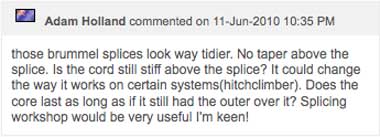
Following the Treetools blog about the "Concerns regarding friction cord splices" prominent Christchurch arborist Adam Holland posed some interesting questions - see comment above.
And… due to the high break-test results for the Locking Brummel splice (22-24kN) on 8mm Armor Prus, other climbers have asked similar questions regarding this type of splice on friction cords. So, it is probably worth furthering the debate. Let's examine Adam's questions.
THE BRUMMEL SPLICE LOOKS WAY TIDIER: The fact the Locking Brummel looks tidier is subjective; some will say it is tidy and some will say it is not! The 'look' of the splice, in this instance, does not influence performance.
IS THE CORD STILL STIFF ABOVE THE SPLICE? There is no taper above the splice, which translates to no 'stiffness' in the cord (stiffness occurs due the depth of bury on a Class I splice). Greater flexibility in the cord make the legs on the Locking Brummel spliced friction cord 'flex' more like a cord with a short, stitched eye like Ocean Polyester (or knotted).
We'll clarify this; one complaint about the Class I splice, when used with a Hitch Climber , is the fact the resulting 'stiff' legs force the prussic knot away from the fairleads on the Hitch Climber. This action changes the dynamics of the prussic knot, which is not to everyone's liking. That's why a few prominent climbers (like James Kilpatrick ) prefer to use a knotted friction cord over a splice.
DOES THE CORE LAST AS LONG AS IF IT STILL HAD THE OUTER (SHEATH) OVER IT? The simple answer, NO!
According to Donahys, the manufacturer of Armor Prus, "the core should be protected at all times" and this can be achieved with both Class I and Class II splices. There are couple of good reasons why the answer is NO.
1) The low melting point of the exposed core. The core of Armor Prus is a lightweight composite made of Spectra and Kevlar. Spectra melts at a relatively low 147.22 deg C and Kevlar decomposes at 426.6 deg C (for reference water boils at 100°C). See previous Treetools blog titled " Temperature guide for ropes". It's the heat resistance of the outer sheath of Armor Prus that has made it so famous as a friction cord.
When a friction cord, with an exposed core Locking Brummel splice, is used in conjunction with a 'slack tending' pulley like a Petzl Fixe or the ISC Eiger there is a high likelihood of rope 'friction' heat being generated.
Rope manufacturer Samson clearly state in their popular Rope Inspection Bulletin : "never let ropes under tension rub together or move relative to one another". That's exactly the situation here.
You can see why Donahy's suggest "the core of Armor Prus should always be protected ."
However, some climbers have argued, when used with a Hitch Climber the 'exposed' spliced eyes are away from the rope so the likelihood of friction heat is significantly lower. YES, BUT… there are still problems with this configuration, which leads to the next issue.
2) Low abrasion resistance of the loose-weave, exposed core. (Under normal conditions with a Class I or Class II splice the Spectra/Kevlar fibres of the Armor Prus core are bound together and protected by the abrasion, and heat, resistant Technora outer sheath).
For a start, the loose weave makes it easy for a climber to 'create a new eye' with the smooth, key-lock nose of a carabiner by inadvertently forcing the nose through the various weaves of the core. This problem can be remedied with the liberal application of Donahys Rope Coat or Yale Maxi Coat.
But more importantly, the exposed core tends to splay (lose its roundness) on the carabiner bar when under load, not unlike a flat tyre.
This presents a potential abrasion problem when used with a Hitch Climber. The hole on the Hitch Climber is slightly bigger than the bar of the carabiner (to accommodate various brands and styles of carabiner). This means the Hitch Climber floats a little on the carabiner bar - not much, but enough to cause the splayed core to spew into the hole between the Hitch Climber and the bar. The Hitch Climber then compresses the exposed core of the Armor Prus against the bar of the carabiner, severely damaging it in no time.
SO… while the Locking Brummel scores high in the break-test results it does not make an ideal splice for 8mm Armor Prus hitch cords (in our opinion).
On that note, we would like to remind readers there is nothing 'official' about the comments above or the Treetools break-tests. We conducted the friction cord splice tests on Armor Prus simply because no one else had done so (or at least the results are not publicly available - to our knowledge).
If more rigorous, academic tests have been completed on the splice-type performance of Armor Prus and similar style friction cords Treetools would be happy to publish and include them in the debate.
SPLICING WORKSHOP WOULD BE VERY USEFUL. Yes, we agree Adam! And, like you we are keen to participate. Jerry Lynch has something planned for Labour Weekend - should be a very interesting weekend in Otago.
More blogs on this subject are bound to follow!
